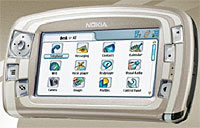 Even the most die-hard Mac hugger is having problems defending the company’s recent litigious spree, where Apple seems determined to become ‘The Man’ and use its corporate power to crush all before it.
Even the most die-hard Mac hugger is having problems defending the company’s recent litigious spree, where Apple seems determined to become ‘The Man’ and use its corporate power to crush all before it.
We find this action particularly strange given the inevitable rise of competition in the portable digital media space. As we’ve saw at CeBIT, the Chinese and Taiwanese MP3-player producing companies have embraced design to good effect. Apple’s iPod crown for the future is now a lot less certain, and given this we’d have thought this would be a time they would be trying to maintain their current friends and make new ones. Instead they appear hell bent on irritating everyone.
First off, there was the case of the bloggers at Apple Insider, PowerPage and Think Secret, mercilessly pursued though the courts after they leaked snippets of Apple’s future plans to their excited audience of Mac users.
Wielding their big white shiny Apple Mac stick, the company successfully won a judgement from the Santa Clara County Superior Court forcing the bloggers to admit to their sources.
The court also granted Apple powers to root around the blogger’s e-mail records in their near-religious quest to track down the culprit.
A wave of international protests followed the ruling by Judge Kleinberg that the laws covering the divulging of trade secrets “outweighed considerations of public interest” with the Guardian newspaper arguing “Was Enron’s off-balance sheet funding structure a “trade secret”, for instance?”
Business Week was equally unimpressed: “Apple has the right to use the legal system to help it punish those who have misappropriated its trade secrets, or to identify employees or partners who may have broken confidentiality agreements.
 But going after the Web sites or forcing them to divulge their sources will put the company in the middle of a freedom-of-speech firestorm that will be a costly distraction for management, and could tarnish the Apple brand.”
But going after the Web sites or forcing them to divulge their sources will put the company in the middle of a freedom-of-speech firestorm that will be a costly distraction for management, and could tarnish the Apple brand.”
Not surprisingly, the EFF was also deeply concerned about the ruling:
“We’re disappointed that the trial court ignored the Supreme Court’s requirement that seeking a journalist’s confidential sources be a ‘last resort’ in civil discovery,” said EFF Staff Attorney Kurt Opsahl. “Instead, the court asserts a wholesale exception to the journalist’s privilege when the information is alleged to be a trade secret.”
“This is a broad-brush ruling that threatens journalists of all stripes,” said EFF Legal Director Cindy Cohn.
Writing in The Scotsman, long time Mac user Stewart Kirkpatrick was equally unchuffed, “In California at least, Apple has destroyed journalism by undermining the most vital tool of our trade: the ability to receive information without having to shop the person who told you.”
Meanwhile, Mac was busy flexing its bully boy corporate muscle in the UK, successfully squashing a smaller company holding prior rights on the iTunes.co.uk domain.
The company registered the name in November 2000 – four years before Apple launched its UK service – with the URL redirecting to their music search engine on CyberBritain.
Apple initiated the complaint because it secretly applied for a UK trademark for the name iTunes on October 27 2000. This application was confidential – known only by Apple, its filing agents and Her Majesty’s Patent Office – and was not published in the TradeMarks Journal until December 6 2000.
After being asked to issue a decision on a complaint through its Dispute Resolution Service, UK domain service registry Nominet has decided that the domain should be handed to Apple.
The owner of iTunes.co.uk, Benjamin Cohen, expressed his frustration. “I must admit that we were not expecting this decision by Nominet’s appointed expert. Apple chose to launch the UK brand of ‘itunes’ within the UK with the knowledge that we had owned the name for three years before their US launch and four years before their launch within the UK,” he said.
“We now face two decisions, whether to appeal to Nominet directly or refer the matter to the High Court. Both of these options are expensive and are not necessarily within the means of a small business. However, the recent High Court victory of Phone4U.co.uk against the major retailer, Phones4U – owned by the Caudwell Group – leads me to think that our case may be extremely strong.”
It’s clear that the Apple self-destruct PR offensive isn’t over yet, with The Register reporting the mysterious case of Google’s vanishing Mac OS X-style interface.
Designed as a tribute to all things Mac, a software engineer had replaced the main text navigation bar on the Google home page with a Mac OS X-style dock sporting a row of eight icons zooming and shrinking as the mouse hovered over them.
The coder was clearly so enamoured with Mac that he included a loving poem above the copyright notice on the Google page: “Roses are red. Violets are blue. OS X rocks. Homage to you”. (sickbag please!)
Sadly, it appears that litigious Apple don’t find anything funny these days, and the design promptly vanished off the Web completely with neither Apple nor Google offering any explanation.
It does seems strange that a company that prides itself for ‘thinking differently’ seems to have embarked on a mission to appear as unpleasant, as ruthless and as willing to crush the little fella as its Redmond neighbours.
With a scathing report in The Guardian concluding that Apple is effectively, “asking to be loathed and subverted”, some pundits are wondering why Apple should actively seek to alienate the people who are its fans and customers.
Put simply, such actions don’t make much business sense.
Google’s X Files disappear
Apple is ‘real loser’ in Think Secret battle
How Apple lost its groove
Nominet backs Apple iTunes domain claim
Blogger lawsuit peels Apple’s shine
 With a lucrative mobile market hungry for content, it’s not surprising to find a host of companies getting their thinking caps on.
With a lucrative mobile market hungry for content, it’s not surprising to find a host of companies getting their thinking caps on. In addition, the winner and two runner-ups each received filmmaking training courses courtesy of Raindance.
In addition, the winner and two runner-ups each received filmmaking training courses courtesy of Raindance. Internet giants Yahoo are preparing to introduce a new service that blends several of the popular features of its site with two of the Web’s fastest growing activities – blogging and social networking.
Internet giants Yahoo are preparing to introduce a new service that blends several of the popular features of its site with two of the Web’s fastest growing activities – blogging and social networking. Even the most die-hard Mac hugger is having problems defending the company’s recent litigious spree, where Apple seems determined to become ‘The Man’ and use its corporate power to crush all before it.
Even the most die-hard Mac hugger is having problems defending the company’s recent litigious spree, where Apple seems determined to become ‘The Man’ and use its corporate power to crush all before it. But going after the Web sites or forcing them to divulge their sources will put the company in the middle of a freedom-of-speech firestorm that will be a costly distraction for management, and could tarnish the Apple brand.”
But going after the Web sites or forcing them to divulge their sources will put the company in the middle of a freedom-of-speech firestorm that will be a costly distraction for management, and could tarnish the Apple brand.” Shipments of MP3 players soared by an enormous 116% in 2004, as hundreds of wallet-tempting products arrived in response to the phenomenal success of Apple iPod player, according to a survey by Market Intelligence firm, iSuppli.
Shipments of MP3 players soared by an enormous 116% in 2004, as hundreds of wallet-tempting products arrived in response to the phenomenal success of Apple iPod player, according to a survey by Market Intelligence firm, iSuppli. The iSuppli report also predicts that HDD-based MP3 player shipments will grow by a CAGR of 41.8% from 2004 to 2009, as compared to 22.9% for flash-based players.
The iSuppli report also predicts that HDD-based MP3 player shipments will grow by a CAGR of 41.8% from 2004 to 2009, as compared to 22.9% for flash-based players. The Comcast deal means that TiVo will have to adapt its software to work on Comcast’s existing DVR platform. This will enable TiVo to blast out the advertising it sells as interactive video clips in their onscreen menu to Comcast subscribers.
The Comcast deal means that TiVo will have to adapt its software to work on Comcast’s existing DVR platform. This will enable TiVo to blast out the advertising it sells as interactive video clips in their onscreen menu to Comcast subscribers. In a board meeting yesterday, Apple computers committed to join the Blu-ray Association and will occupy a seat on the main board.
In a board meeting yesterday, Apple computers committed to join the Blu-ray Association and will occupy a seat on the main board. Blu-ray has been shipping in Japan now for quite some time. Sony’s BDZ-S77 (catchy name) was the first product to ship, and has been followed by other companies, some of which support the dual-layer 50Gb version.
Blu-ray has been shipping in Japan now for quite some time. Sony’s BDZ-S77 (catchy name) was the first product to ship, and has been followed by other companies, some of which support the dual-layer 50Gb version. (Hannover, Germany) Since November, Vodafone has been offering Vodafone At Home Talk in Germany. When using the service, calls that are made from the subscriber’s home cell are charged at a low cost, with one of the bundles available being 1,000 mins for €20 month.
(Hannover, Germany) Since November, Vodafone has been offering Vodafone At Home Talk in Germany. When using the service, calls that are made from the subscriber’s home cell are charged at a low cost, with one of the bundles available being 1,000 mins for €20 month. In the UK
In the UK  During the press conference I asked what they were doing to counter the threat of Voice over WiFi, in particular free service like Skype. Friedrich P Joussen (COO) said they were very aware of the threat and felt it was down to the speed that services could be rolled out to the public.
During the press conference I asked what they were doing to counter the threat of Voice over WiFi, in particular free service like Skype. Friedrich P Joussen (COO) said they were very aware of the threat and felt it was down to the speed that services could be rolled out to the public. Apple Computer shares dropped Tuesday as Sony relaunched its famous Walkman line amongst concerns that increased competition from Napster might impact its dominance of online music and portable players.
Apple Computer shares dropped Tuesday as Sony relaunched its famous Walkman line amongst concerns that increased competition from Napster might impact its dominance of online music and portable players. Over the last twelve months, Apple’s share price has gone from US$23 (€17/£12) to an all-time high of US$81.99 (€61/£42) just before the split was announced.
Over the last twelve months, Apple’s share price has gone from US$23 (€17/£12) to an all-time high of US$81.99 (€61/£42) just before the split was announced. (CeBIT, Hannover) Wandering around the Sony products at the pre-CeBIT press conference, I came across the DSC-T7, the smallest, sexiest model whos roots lay with the DSC-T1.
(CeBIT, Hannover) Wandering around the Sony products at the pre-CeBIT press conference, I came across the DSC-T7, the smallest, sexiest model whos roots lay with the DSC-T1. a sliding cover that both covers and protects the lens and switches the camera on. Measuring only 14.8 mm / 0.6 in at the lens cover, and 9.8 mm / 0.4in for the main body, it packs 5.1m pixel. The back is taken up with a 2.5″ TFT Hybrid LCD, displaying 230,000 pixels.
a sliding cover that both covers and protects the lens and switches the camera on. Measuring only 14.8 mm / 0.6 in at the lens cover, and 9.8 mm / 0.4in for the main body, it packs 5.1m pixel. The back is taken up with a 2.5″ TFT Hybrid LCD, displaying 230,000 pixels.
 Nothing definite on release dates or price but the talk in the corridors is it should be around in May for around 375Euro, $500, 260 UKP.
Nothing definite on release dates or price but the talk in the corridors is it should be around in May for around 375Euro, $500, 260 UKP. Finnish telecommunications equipment giant Nokia has announced a mobile television pilot, bringing live television broadcasts to mobile devices, starting in Finland today.
Finnish telecommunications equipment giant Nokia has announced a mobile television pilot, bringing live television broadcasts to mobile devices, starting in Finland today. The mobile TV test uses IP Datacasting (IPDC), which conforms with the DVB-H standard.
The mobile TV test uses IP Datacasting (IPDC), which conforms with the DVB-H standard.